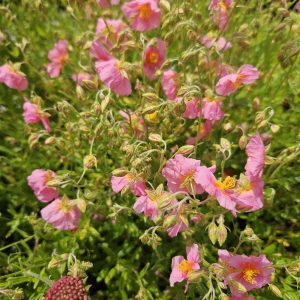Helianthemum, commonly known as Rock Rose or Sun Rose, is a charming and sun-loving perennial that adds vibrant colours to your garden. Follow this planting guide to ensure successful establishment and flourishing of your Helianthemum plants:
Site Selection
Sunlight Requirements: Plant Helianthemum in a location that receives full sunlight for at least 6 hours a day. These plants thrive in bright, sunny conditions.
Well-Draining Soil: Choose a well-draining soil with a slightly alkaline to neutral pH. Helianthemum prefers soil that doesn’t stay consistently wet.
Planting Time
Spring or Autumn: Plant Helianthemum in the spring or autumn when the soil is workable. Avoid planting during the hottest part of summer or extreme cold conditions.
Planting Process
Spacing: Space Helianthemum plants according to their mature size, usually around 12 to 18 inches apart. This provides adequate room for spreading and promotes good air circulation.
Container Planting: Helianthemum can be grown in containers. Use a well-draining potting mix and ensure the container has drainage holes.
Planting Depth: Plant Helianthemum at the same depth as they were in the nursery container. Water thoroughly after planting.
Watering
Establishment Period: Water Helianthemum regularly during the first few weeks after planting to help them establish. Once established, they are drought tolerant.
Deep Watering: Water deeply when the top inch of soil feels dry, especially during dry spells. Avoid overwatering to prevent root rot.
Mulching
Mulch Application: Apply a thin layer of organic mulch around the base of Helianthemum plants. Mulch helps conserve moisture, suppress weeds, and regulate soil temperature.
Fertilisation
Minimal Fertilisation: Helianthemum plants are not heavy feeders. Apply a balanced, slow-release fertiliser in the spring when new growth appears.
Pruning
Deadheading: Regularly deadhead spent flowers to encourage continuous blooming. Trim back the entire plant lightly after the first flush of flowers to promote a compact shape.
Support
Generally Not Required: Helianthemum plants are low-growing and usually don’t require staking or support.
Pest and Disease Management
Pest Monitoring: Helianthemum is generally resistant to pests. Monitor for aphids or spider mites and treat if detected.
Good Air Circulation: Ensure good air circulation around the plants to reduce the risk of fungal diseases.
Winter Care
Minimal Winter Care: Helianthemum is generally hardy and requires minimal winter care. Prune lightly in late autumn to tidy up the plant.
Monitoring and Adjustment
Visual Inspection: Regularly inspect Helianthemum plants for signs of stress, pests, or diseases. Adjust watering and care practices based on your observations.
Enjoy the Blooms
Blooming Season: Revel in the profusion of colourful blooms produced by your Helianthemum plants, typically from late spring to early summer.
By following this planting guide, you’ll create an optimal environment for your Helianthemum plants to thrive. Customise care based on your local conditions and the specific requirements of the Helianthemum variety you have chosen.






